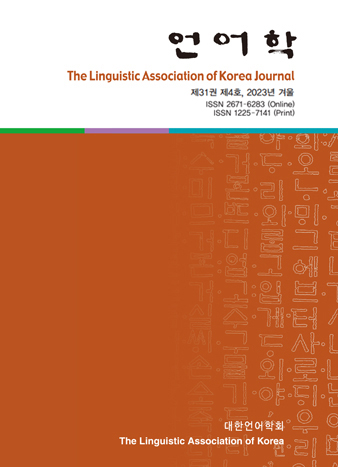대한언어학회 전자저널

31권 4호 (2023년 12월)
- 동사이동은 통사이동으로 부적절한가?
-
김대익
Pages : 35-55
Abstract
Keywords
# 동사이동(verb movement) # 통사부(syntax) # 음성부(PF) # 의미부(LF) # 최소주의(minimalism) # 병합(Merge) # 다중지배(multi-dominance) # 어순 공리(LCA) # 혼합체(amalgamation) # 인접(adjunction)
References
- 김대익. (2021). 동사이동과 짝병합. 현대문법연구, 60, 47-68.
- Baker, M. (1985). The mirror principle and the morphosyntactic explanation. Linguistic Inquiry, 16, 373-415.
- Baltin, M. (2002). Movement to the higher V is remnant movement. Linguistic Inquiry 33, 653-669.
- Boeckx, C., & Stjepanović, S. (2001). Head-ing towards PF. Linguistic Inquiry, 32, 345-355.
- Brody, M. (2000). Mirror principle. Syntactic representation in perfect syntax. Linguistic Inquiry, 31, 29-56.
- Chomsky, N. (1957). Syntactic structures. The Hague: Mouton.
- Chomsky, N. (1991). Some notes on economy of derivation and representation. ms. MIT. [Reprinted in The minimalist program, (pp. 129-166). Cambridge, Mass.: MIT Press, 1995.]
- Chomsky, N. (1993). Minimalist program for linguistic theory. ms. MIT.
- Chomsky, N. (1995). The minimalist program. Cambridge. Cambridge, Ma: MIT Press.
- Chomsky, N. (2000). Minimalist inquiries: the framework. In R. Martin, D. Michaels, & J. Uriagereka (Eds.), Step by step: essays on minimalist syntax in honor of Howard Lasnik (pp. 89-157). Cambridge, Ma: MIT Press.
- Chomsky, N. (2001). Derivation by phrase, In M. Kenstowicz (Ed.), Ken Hale: a life in language (pp. 1-53). Cambridge, Ma: MIT Press.
- Chomsky, N. (2004). Beyond explanatory adequacy in structures and beyond. In A. Belletti (Ed.), The cartography of syntactic structures (pp. 104-131). New York: Oxford University Press.
- Chomsky, N. (2013). Problems of projection. Lingua, 130, 33-49.
- Chomsky, N. (2015). Problems of projection: extensions. In E. Domentico, C. Hamann & S. Matteini (Eds.), Structures, strategies and beyond: studies in honor of Adrian Belletti (pp. 3-16). Amsterdam: John Benjamins.
- Chomsky, N. (2019). Some puzzling foundational issues: The reading program. Catalan Journal of Linguistics. Special Issue, Generative syntax: questions, crossroads, and challenge (pp. 263-285). https://revistes.uab.cat/catJL/article/view/sp2019-chomsky
- Chomsky, N. (2021). Minimalism: where are we now, and where can we hope to go. Gengo Kenkyu, 160, 1-41.
- Chomsky, N. (2023). The miracle creed and SMT. ms. (to appear).
- Citko, B. (2005). On the nature of merge: external merge; internal merge, and parallel merge. Linguistic Inquiry, 36, 475-96.
- Dékány, É. (2018). Approaches to head movement: a critical assessment. Glossa: A Journal of General Linguistics, 3(65), 1-43.
- Edmonds, J. (1978). The verbal complex V′- V in French. Linguistic Inquiry, 9, 151-175. Fiengo, R. (1977). On trace theory. Linguistic Inquiry, 8(1), 35-62.
- Grodzinsky, Y., & Finkel, L. (1998). The neurology of empty categories aphasics' failure to detect ungrammaticality. Journal of Cognitive Neuroscience, 10(2), 281-292.
- Kayne. S. (1989). Notes on English agreement. Unpublished manuscript. New York: Graduate Center, CUNY.
- Lapointe, S. (1980). A lexical analysis of the English auxiliary verb system. In T. Hoekstra, H. van der Hulst & M. Moortgat (Eds.), Lexical Grammar, 215(54). Dordrexcht: Foris.
- Lecher, W. (2005). Interpretive effects of head movement. Unpublished manuscript. University of Tübinggen.
- Matushansky, O. (2006). Head movement in linguistic theory. Linguistic Inquiry, 37, 69-109.
- Moro, A., & Roberts I. (2023). The duality of syntax: unstable structures, labelling and linearization. Unpublished manuscript.
- Pollock, J. Y. (1989). Verb movement, UG and the structure of IP. Linguistic Inquiry, 20, 365-424.
- Schoorlemmer, E., & Temmerman, T. (2012). Head movement as a PF phenomenon: evidence from identity under ellipsis. In C. Jaehoon, E. Hogue, J. Punske, D. Tat, J. Schertz & A. Trueman (Eds.), Proceedings of the 29th West Coast Conference on Formal Linguistics (pp. 232–240). Somerville, MA: Cascadilla Proceedings Project.
- Roberts, I. (2010). Head movement and the minimalist program. Unpublished manuscript.
- Omune, J. (2019). A merge-based approach to head adjunction. Journal of Inquiry and Research, 109, 167-185.
- Ouhalla, J. (1991). Functional categories and parametric variation. New York: Routledge.
- Travis, L. (1984). Parameters and effects of word order variation. doctoral dissertation, Massachusetts Institute of Technology, Cambridge, MA